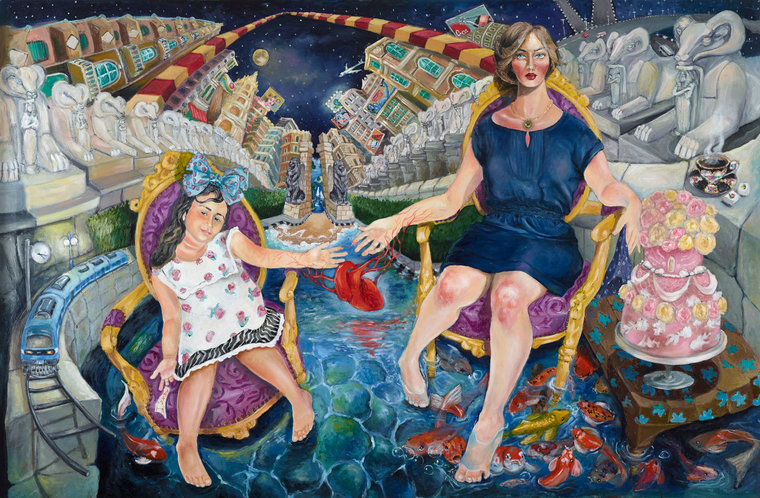There is a Place like no place on earth, 2014, by Egyptian artist Riham El Sadany presents a surreal, immersive composition. At its center, a woman and a young girl sit on ornate chairs, holding hands over a stream filled with orange koi fish. A heart floats between them, connecting them through their veins. Both gaze outward with calm, distant expressions. They are framed by a fantastical environment, with curved architecture rising into a star-filled sky, flanked by symmetrical rows of ram-headed sphinxes (representing the power of the pharaoh). On the right, a tall pink cake and several goldfish rest on the tiled surface; on the left, a metro train speeds into view. The scene merges interior and exterior, history and imagination, in a richly layered space where perspective bends and logic softens.
This visual language reflects El Sadany’s broader artistic world, one of dramatic fantasy, where the boundaries between reality and the unconscious are fluid. She masterfully navigates the space between the visible and invisible dimensions of the human psyche, often layering objects, spaces, and symbols in ways that create optical illusions and emotional dissonance. Her compositions do not separate fantasy from truth; rather, they use imagination to reframe psychological and social realities. Women are always at the center of El Sadany’s practice. Often depicted as bulky and muscular, they are neither hardened nor distant, but tender, romantic, and emotionally vibrant. This recurring portrayal affirms her belief in women’s complexity, power, and capacity for transformation even within rigid or patriarchal structures. Her figures do not submit to external gazes but live confidently within their own emotional worlds. They guide, create, and bear witness to the spaces around them.
El Sadany has described the world of women as the one she knows best and, as such, it is the core of her visual imagination. She draws from Surrealism, the childlike spontaneity of Picasso, and Frida Kahlo’s ability to translate pain into deeply symbolic form. Her compositions do not follow a linear or didactic narrative; they unfold like “mental maps of imaginary terrain,” shaped by memory, intuition, and psychic depth. Her visual environments are often informed by Egyptian landmarks such as the Avenue of Sphinxes or the Kings Festivities Road, which is also known as Rams Road – a long avenue with sphinxes and ram-headed statues lining up both sides. El Sadany chooses these motifs not only for their historical symbolism, but also their sense of silent energy. These elements hover in her work like spectral presences, echoing the past while also affirming its presence and power in the present.
In There is a Place like no place on earth, the real and the imagined coexist. The comforting and the uncanny are intertwined. Bringing in the surrealist tendencies, the known world is overlaid with what is repressed or remembered. This richly layered emotional space reflects El Sadany’s central preoccupation: constructing parallel realms where women’s inner lives, ancestral echoes, and imaginative freedom are not only visible but foundational.




